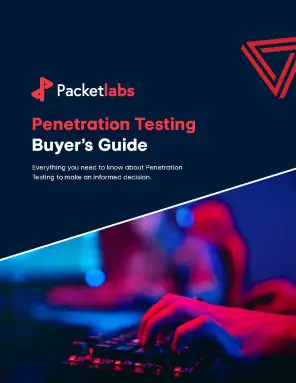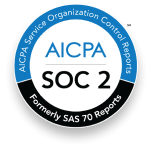Threats
How to Identify Fake Websites: 10 Warning Signs
- What Are Fake Websites? How Are They Used in Phishing Scams?
- 10 Ways to Identify a Fake Website in 2025
- 1. Check the Domain Name
- 2. Use a Website Checker or Safe Browsing Tools
- 3. Look for Poor Spelling and Design Inconsistencies
- 4. Verify the Domain Age
- 5. Be Cognizant of Deals That Seem “Too Good to Be True”
- 7. Seek User Reviews
- 8. Read the Shipping and Return Policies
- 9. Exercise Caution Regarding Non-Traditional Payment Methods
- 10. Run a Virus Scan
- Bonus: Verify the Company Name
- What to Do if You Have Clicked on a Fraudulent Website (Or Clicked on a Suspicious Link)
- How to Report a Fake Website in 2025
- Conclusion
Would you like to learn more?
Download our Guide to Penetration Testing to learn everything you need to know to successfully plan, scope and execute your penetration testing projects
Do you know how to identify fake websites in 2025 and beyond?
Fraudulent websites are an integral part of nearly all sophisticated phishing scams— and they’re only getting more prevalent. According to the Anti-Phishing Working Group (APWG)'s quarterly phishing activity trend report, nearly 1.8 million new phishing and fake websites were discovered in the last half of 2024 alone–which is only expected to increase throughout 2025.
Threat actors create convincingly fake websites that mirror bank login pages, password reset pages for services like Amazon and Netflix, or package delivery requests. But any information you enter goes straight to the scammers— who then use it for identity theft or financial fraud.
In this guide, we’ll explain how fake websites work, how you can identify a fraudulent website (with examples), and what to do if you accidentally visit or enter information when targeted by a phishing scam.
A Note on Common Website Fraud in the Cybersecurity Industry:
Domains that mimic the URL of existing websites, unsanctioned guest blogs, and copied job postings from legitimate sites are all common phishing scams threat actors employ.
When applying for a career at Packetlabs–or researching the Packetlabs brand, whether it be on a search engine or social media–please note that legitimate jobs at Packetlabs will be found only on our website (packetlabs.net) and via our official LinkedIn page.
Be aware that we never ask candidates for personal information such as personal identification, or banking information during the interview process. We do not interview prospective candidates via instant message or group chat, do not require candidates to purchase products or services, and do not request that candidates process payments on our behalf as a condition of any employment offer.
For further information–or if you feel you may have been targeted by a recruitment fraud related to Packetlabs–please contact our hiring team at info@packetlabs.net.
What Are Fake Websites? How Are They Used in Phishing Scams?
Threat actors create fake websites to persuade you into sharing sensitive information, such as account passwords, payment details, or personal information they can use to steal your identity. Some fake websites can even infect your device with malware or trick you into buying non-existent or counterfeit products.
While some fraudulent websites are designed to be found organically while you’re browsing the internet, most are made to be linked to in part of larger phishing scams. Fraudsters send scam emails, texts, or messages with links to websites that may look legitimate, but are designed to steal your passwords, personal data, and financial information.
Here are some of the most common ways that scammers use fake websites:
Fake online stores with too-good-to-be-true deals. Scammers create fake online stores offering incredible deals, and then run ads for them on social media. These sites either steal your payment information or trick you into buying fraudulent products
Fraudulent password login pages. Fraudsters create sites that look like login pages (for your bank, Netflix, etc.) and then include links to them in phishing messages. For example, you may receive a phishing email claiming that your bank account has been compromised and that you should click the link and enter your password and banking details to secure your account
Malicious pop-ups that download malware. Threat actors create pop-ups on legitimate websites that download malware onto your device. Once installed, they can spy on you or scan your hard drive for sensitive information
Fake customer support websites. Scammers pretend to be from technical support companies and get you to give them remote access to your computer
Fraudulent health insurance websites. Criminals may also target your healthcare information by creating fake websites that ask you to “verify” your insurance number
Fake package delivery websites. With the increase of online shopping, scammers create fake websites that look like they’re from UPS, FedEx, USPS, and others. These fake sites ask you to verify your address and other personal information or try to trick you into giving up your credit card information
Fraudulent flight-booking websites. In a recent fake website scam, fraudsters create fake airfare-booking websites that steal your personal information (passport number, credit card, etc.) or sell you fake tickets
10 Ways to Identify a Fake Website in 2025
Check the domain name
Use a website checker or safe browsing tools
Look for poor spelling, design inconsistencies, and other common red flags
Be wary of deals that seem too good to be true
Look for user reviews, and check for reports of scams
Read the shipping and return policy
Beware of non-traditional payment options
Don’t be conned by “trust signals”
Run a virus scan
1. Check the Domain Name
The easiest way to tell that you’re on a fake website is when the domain name doesn’t match the official website for the company. For example, scammers often use domain names that are similar to — or even contain — the official URL within the fake domain name.
Here are a few examples of how scammers spoof website domains:
Packetlabss.net (adding an extra “s”)
Paypal.com.secure-site.com (in this case, the domain name is actually “secure-site.com” not “paypal.com”)
CbC.com (using a lowercase "b" instead of an uppercase)
Amazon-support.net (combining a spoofed domain with a different domain extension)
In summary: Always check that you’re on the right domain before entering sensitive information. Unless you’re sure that you’re on a company’s official domain, you could be dealing with a fake website.
2. Use a Website Checker or Safe Browsing Tools
A website checker helps you answer if a website is safe to visit. For example, it tells you if the site uses encryption to protect your data, along with the site’s level of verification certificate.
There are some good free resources that you can use to check if a website is safe to use.
Google Transparency Report is a free resource that examines billions of URLs daily to find unsafe or compromised websites. Google reports dangerous or infected sites to their owners and also warns visitors in browsers like Google Chrome.
URLVoid is another tool that scans URLs for dangerous content and checks them against databases of known scam websites.
In summary: Although they add a layer of protection, website checkers cannot be used as a catch-all against fraudulent sites.
3. Look for Poor Spelling and Design Inconsistencies
Threat actors move quickly and often don’t want to take too long building fake websites (which could be identified as fraudulent and get taken down). Similar to scam emails and texts, phishing websites often include basic flaws and mistakes that legitimate companies wouldn’t miss.
Look for these design and content warning signs that typically indicate you’re on a phishing website:
Poor spelling and grammar. Large companies employ teams of writers and editors who quickly fix spelling mistakes or poor grammar that could slip through the cracks
Pixelated or low-quality images. Threat actors don’t always have access to the right sized images or logos. Visual designs and logos on fake websites often look low-quality or blurry
No “About Us” page or contact information. Scammers typically include fake contact information (or none at all). If you can’t find information about the company on their website, it could be a scam. Also, beware if the only way to communicate with the company is through a generic contact form. Ideally, you should be able to find the company’s physical address and phone number on their site
In summary: If a website feels too unpolished, it’s advised to take that as a sign that it may not be legitimate.
4. Verify the Domain Age
Fraudulent sites rarely stay online for long. One way to tell if a website is real or fake is to check how long it’s been active by using the Whois Lookup domain tracker.
Enter the website’s URL and you’ll be able to see details such as the owner’s organization name, country of registration, and age of the domain. It’s probably a fake website if the company claims to be registered in the United States, but their Whois Lookup query shows that they’re in another country.
Alternatively, leverage the Wayback Machine to see archived versions of the website and determine if it’s been used for multiple purposes.
In summary: Fake sites are often taken down–and put back up–multiple times due to complaints. As such, verifying the domain age oftentimes holds an important clue regarding the legitimacy of a site.
5. Be Cognizant of Deals That Seem “Too Good to Be True”
Threat actors know that you’re willing to set your suspicions aside for a good deal.
When shopping online, don’t be fooled into trusting sketchy websites because you might save money. These fake shopping sites either steal your financial information or send you cheap knock-off versions of the items that you think you’re buying.
A good rule of thumb is that if a site advertises prices that are all 50+% off, you should take steps to confirm it’s not a fake website. For example, verify it with a website checker, look for spelling and grammar mistakes, and check the domain age and information against what’s listed.
In summary: Spear phishing tactics often leverage deals that are too enticing to pass by. It is recommended to exercise caution when clicking on links online, particularly regarding shopping.
7. Seek User Reviews
In an effort to look more legitimate, scammers often post fake reviews on their websites. But at the same time, real customers (who might have gotten scammed) can also write reviews warning you about their experiences.
Read on- and off-site reviews for mentions of fraud, non-delivery, or even identity theft. While you’re checking reviews, see if anything feels off. Scammers often create fake bot accounts on review sites in order to build trust.
Here’s how to spot fake reviews:
Reviews reuse phrasing
The reviews lack details that a real shopper would include (or contain overly specific details)
The reviewers are all relatively new to the platform or were posted in bulk
Be cautious if you run into multiple generic reviews that are unusually positive and lack accurate descriptions of the product experience
In summary: If there aren’t any reviews on the site, you can run a Google search for “Is [website name/URL] real/a scam?” The Better Business Bureau’s Scam Tracker is also a reputable tool to check for negative reviews about a company.
8. Read the Shipping and Return Policies
Official retailers have a dedicated webpage detailing their shipping and return policy. If the website you’re on doesn’t explain how to return an item, it’s a scam.
In summary: The website should also include basic legal information, such as its terms and conditions, privacy policy, and data collection policy. If you can’t find this information, it’s likely not a legitimate company.
9. Exercise Caution Regarding Non-Traditional Payment Methods
Fake websites sometimes try to force you to pay for goods using non-reversible or non-traceable payment methods— such as gift cards, bank transfers, cryptocurrencies, or payment apps like Zelle, Cash App, and Venmo.
In summary: Legitimate brands will always give you the option of paying with more traditional and safer method— including credit and debit cards, PayPal, or “buy now, pay later” options.
10. Run a Virus Scan
Sometimes the goal of a fake app or website isn’t to steal your information, passwords, or money—but to infect your device with malware.
Hackers create pop-ups and ad-riddled websites that can infect your phone or computer with viruses that let cybercriminals spy on you, scan your device for sensitive data, or lock your device until you pay a ransom.
If you’ve been to a site like this recently, you need to make sure your device hasn’t been compromised.
In summary: Just like a website checker, a virus scan does not guarantee safety against malware. It is recommended to conduct periodic, in-depth Employee Awareness Training so that protection can be proactive vs. reactive.
Bonus: Verify the Company Name
A corporate search (for example, this tool based out of the United States) may reveal the company doesn't exist.
It is advised to cross-reference company names with its listed name on social media, job websites, and related searches to ensure the company name is legitimate.
What to Do if You Have Clicked on a Fraudulent Website (Or Clicked on a Suspicious Link)
Call your insurance provider. If you have identity theft insurance (or a digital security service like Aura that includes insurance coverage), call your provider and ask what to do
Freeze your credit. A credit freeze stops anyone from accessing your credit file and makes it harder for scammers to open new accounts or loans in your name
Update your passwords and enable two-factor authentication (2FA). If scammers have access to your accounts (social media, email, banking, etc.), you’ll need to regain control of them. Then, update all of your passwords to be more secure and enable 2FA for added security
Notify your bank and credit card companies’ fraud departments. Explain that a threat actor has potentially gotten a hold of your banking information. They’ll help you close your accounts and issue you new cards and account numbers
Try to reverse the fraudulent payment. Reach out to the company that facilitated the payment and ask to reverse it. You can also contact the company from which you bought gift cards and explain the situation
Scan your devices for malware. Use antivirus software to scan your devices for lingering malware or remote access software that threat actors may have installed
Bonus: In the fight against threat actors, it’s not a matter of “if”–it’s a matter of “when.” And in the fight against threat actors, offensive security is power.
As a CREST and SOC 2 Type II accredited penetration testing firm, Packetlabs’ best in class methodologies and 100% tester-driven pentesting go well beyond industry standards. We offer several solutions that push the envelope on security–and guarantee full regulatory and cyber insurance compliance.
How to Report a Fake Website in 2025
Reporting fake websites helps make the internet safer for everyone. If you come across a fake website, here’s what you should do:
Report a phishing site or any malicious websites to Google (this will block them in Google Chrome, Mozilla Firefox, Opera, and other browsers)
Report the fake site to Microsoft (this will block it in Microsoft Edge and Internet Explorer)
For those based in the United States: Report scam sites to the FTC at ReportFraud.ftc.gov or by calling 1-877-382-4357 and report the fake site to the FBI’s Internet Crime Complaint Center (IC3)
For those based in Canada: Contact the Fraud Reporting System (Canadian Anti-Fraud Centre) or call toll-free at 1-888-495-8501
For those based in the United Kingdom: Report attempted phishing to the Action Fraud or by calling 0300 123 2040
For those based in Australia: Contact Scamwatch to report attempted fraud
Conclusion
Knowing how to identify a fake website in 2025 is critical.
Looking to identify risks before they become headlines? Contact the Packetlabs team today.
Let's Connect
Share your details, and a member of our team will be in touch soon.
Interested in Pentesting?

Penetration Testing Methodology
Our Penetration Security Testing methodology is derived from the SANS Pentest Methodology, the MITRE ATT&CK framework, and the NIST SP800-115 to uncover security gaps.
Download Methodology
Penetration Testing Buyer's Guide
Download our buyer’s guide to learn everything you need to know to successfully plan, scope and execute your penetration testing projects.
Download GuideExplore in-depth resources from our ethical hackers to assist you and your team’s cyber-related decisions.

September 13 - Blog
Why Multi-Factor Authentication is Not Enough
Knowing is half the battle, and the use and abuse of common frameworks shed insight into what defenders need to do to build defense in depth.

November 19 - Blog
The Top Cybersecurity Statistics for 2024
The top cybersecurity statistics for 2024 can help inform your organization's security strategies for 2025 and beyond. Learn more today.

October 24 - Blog
Packetlabs at SecTor 2024
Packetlabs is thrilled to have been a part of SecTor 2024. Learn more about our top takeaway's from this year's Black Hat event.

- Toronto | HQ
- 401 Bay Street, Suite 1600
- Toronto, Ontario, Canada
- M5H 2Y4
- San Francisco | HQ
- 580 California Street, 12th floor
- San Francisco, CA, USA
- 94104
© 2024 Packetlabs. All rights reserved.






